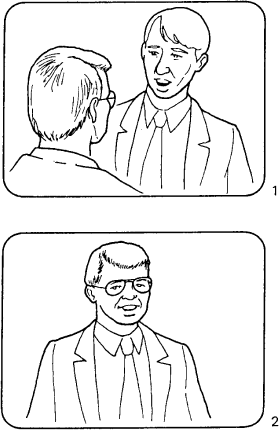Cutaway Questions
Reporter cutaway questions (inserts or reverses) are recorded in case the picture editor needs to bridge chosen sections of an interview shot on a single camera. It is a cinematic editing device, the intention being to avoid the ugly, on-screen ‘jump cut’.
For the reporter, the technique relies on an ability to repeat the original questions for the camera as naturally as in the interview, even though the interviewee is probably no longer with you. Consult your original list or replay the interview to ensure keeping to the questions as closely as possible. Some sticklers for accuracy record their interviews on personal cassette-machines and play them back before asking the cutaways. While it is probably just about acceptable to tidy up the occasional grammatical error, be careful not to cheat by putting an entirely different construction on a question.
Noddies
Serving the same purpose as the cutaway is the ‘noddy’–a shot of the reporter nodding in response to the interviewee’s answer. This device should be used sparingly, as a ‘noddy’ could give a misleading impression that you agree with what is being said. Some news organisations ban ‘noddies’ and cutaway questions altogether, in the belief that the viewer has a right to be aware that editing has taken place.
Both devices depend on a correct positioning of the camera. If it is wrong, the edited version will give the impression that interviewer and interviewee are looking in the same direction, not at each other.
Interview editing
In countries where a degree of press freedom exists, it is understood that television interviews are subject to editing, those for news and news-related programmes most of all.
Yet the whole subject remains an area of controversy, an ever-present source of potential conflict–not so much with those in the public eye, but with those who are unfamiliar with journalistic practice. The complaint is then usually of ‘misrepresentation’ or ‘distortion’. Regrettably there is often no answer which will satisfy the complainant, although it should be possible to prove that you have acted fairly and in good faith.
The main thing is never to give an undertaking to include or exclude a particular answer or passage. Whatever your own good intentions, it might be impossible to keep your promise, as the decision about editing may rest with someone more senior. In all cases, before you start to interview an inexperienced person it is advisable to make it clear that you are under no obligation to use all or any of what is said.

Cutaway questions
When a single camera is used it concentrates on the interviewee (1). Shots of the reporter are taken afterwards to act as a bridge between edited sections, thus avoiding ugly ‘jump-cuts on the screen’. (2) Unless care is taken in setting up these ‘cutaway questions’ both interviewee and interviewer will seem to be looking in the same direction, not at each other. The technique is beginning to fall out of favour for news-type programmes.ection, not at each other. The technique is beginning to fall out of favour for news-type programmes. out of favour for news-type programmes.
